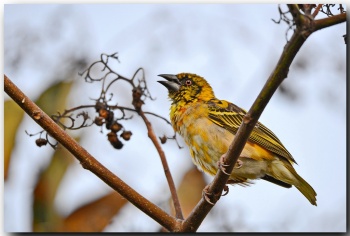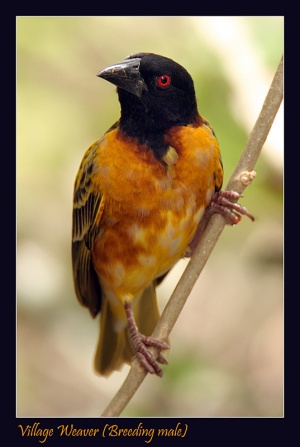- Ploceus cucullatus
Identification
15-17cm (6-6¾ in)
Strong conical bill
Breeding male
- Black head and bill
- Chestnut nape
- Upperparts and wings are yellow and black
- Yellow underparts
Non-breeding male
- Yellow head
- Olive crown
- Grey upperparts
- Whitish underparts
- Yellow and black wings
- Red eyes
Adult female
- Dark eyes
- Streaked olive upperparts
- Yellow and black wings
- Pale yellow underparts
Young birds browner back, otherwise similar to the female
Variation
Most subspecies have mostly dark head but differ in color of nape and back of male. The southernmost subspecies spilonotus differ in having a black mask that only reaches the side of the bill and is yellow above that.
Distribution
Sub-Saharan Africa
Western Africa: Mauritania, Senegambia, Senegal, The Gambia, Guinea-Bissau, Guinea, Mali, Sierra Leone, Liberia, Ivory Coast, Burkina Faso, Ghana, Togo, Benin, Nigeria, Niger, Chad, Cameroon, Central African Republic, Equatorial Guinea, Gabon, Democratic Republic of Congo, Angola
Eastern Africa: Sudan, South Sudan, Eritrea, Ethiopia, Somalia, Kenya, Uganda, Rwanda, Burundi, Tanzania, Zambia, Mozambique, Malawi
Southern Africa: Namibia, Botswana, Zimbabwe, South Africa, KwaZulu-Natal, Lesotho, eSwatini
African Islands: Gulf of Guinea Islands, Bioko (Fernando Po), Sao Tome, Principe, Mauritius Island and Reunion Island.
Escaped populations can be found in many countries world-wide and has been introduced to Haiti.
Taxonomy

Photo © by volker sthamer
Hawassa, Ethiopia, February 2017
Subspecies
Ploceus cucullatus has eight subspecies:[1]
- P. c. cucullatus
- Mauritania to Chad, south to northern Gabon and north-western DRC; also Bioko
- P. c. collaris
- P. c. bohndorffi
- Northern Gabon, Central African Republic, northern Democratic Republic of the Congo, southwestern South Sudan, Uganda, western Kenya, and northwestern Tanzania
- P. c. frobenii
- Southern DRC
- P. c. graueri
- P. c. abyssinicus
- Eritrea, Ethiopia, southeastern Sudan, and eastern South Sudan
- P. c. nigriceps
- Southern Somalia to Kenya, Tanzania and northern Mozambique; also São Tomé
- P. c. spilonotus
- South-eastern Botswana to southern Mozambique, South Africa and Lesotho
Habitat
They occupy a variety of open habitats, from open woodlands to towns and villages.
Behaviour
They often form large noisy colonies.
Breeding
The large nest is coarsely woven from grass and leaf strips, suspended from a branch. It has a downward facing entrance. The clutch consists of 2-3 eggs.
A colonial breeder, many nests may be found in a single tree.
Diet
Their diet consists mostly of seeds and grain, and can be a crop pest; also insects, particularly when feeding young.
Vocalisation
Call: includes harsh buzzes and chattering
References
- Clements, J. F., T. S. Schulenberg, M. J. Iliff, S. M. Billerman, T. A. Fredericks, B. L. Sullivan, and C. L. Wood. 2019. The eBird/Clements Checklist of Birds of the World: v2019. Downloaded from http://www.birds.cornell.edu/clementschecklist/download/
- Avibase
- Avian Web
Recommended Citation
- BirdForum Opus contributors. (2024) Village Weaver. In: BirdForum, the forum for wild birds and birding. Retrieved 25 April 2024 from https://www.birdforum.net/opus/Village_Weaver
External Links
Search the Gallery using the scientific name:
Search the Gallery using the common name:
GSearch checked for 2020 platform.








